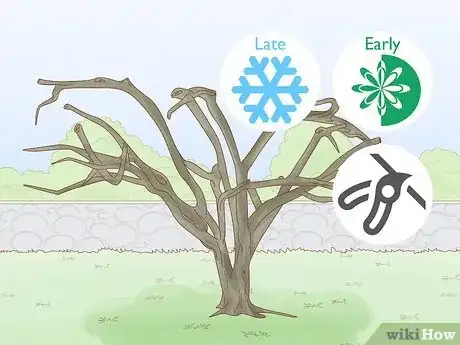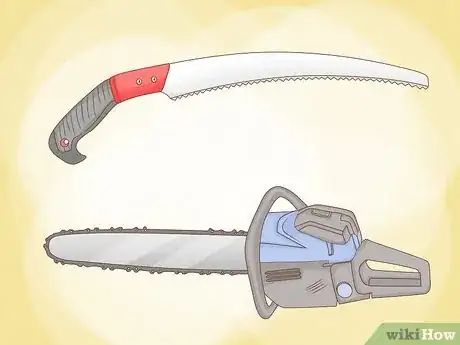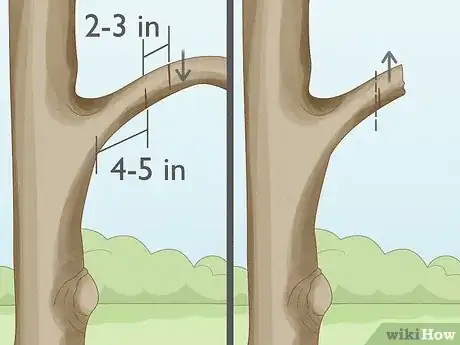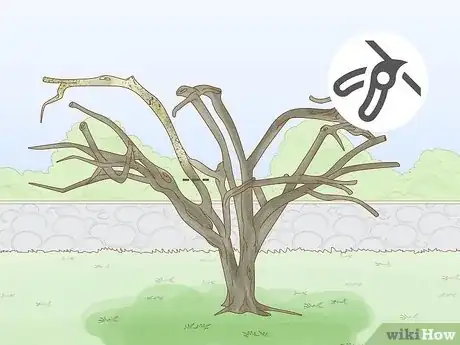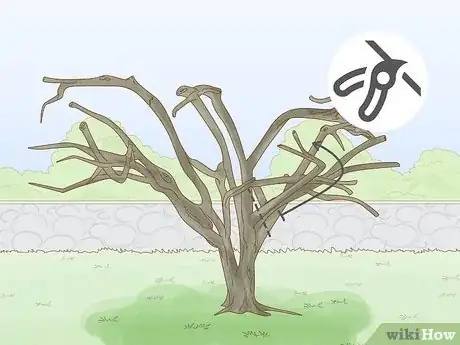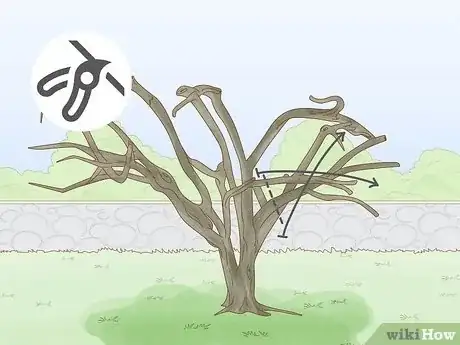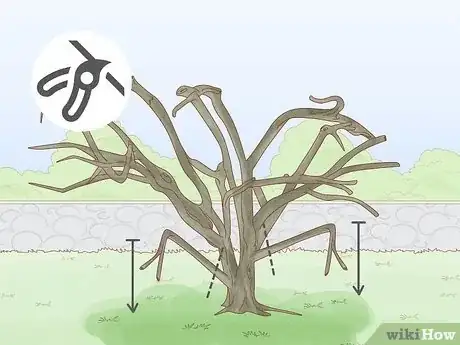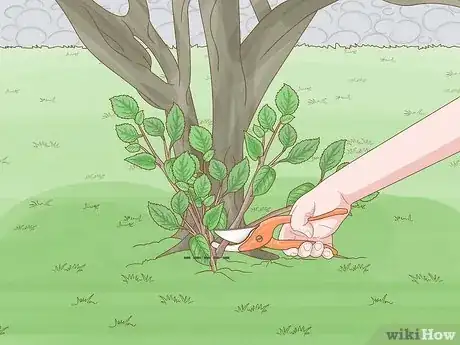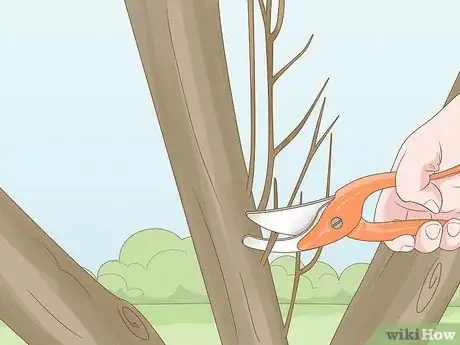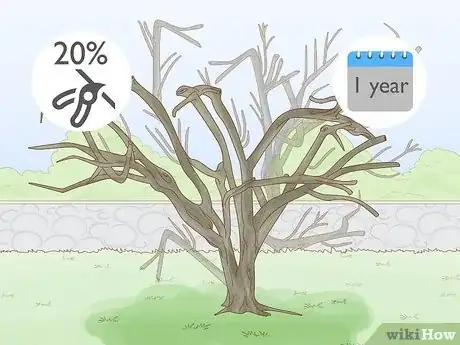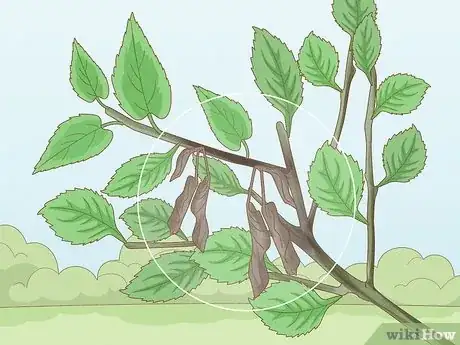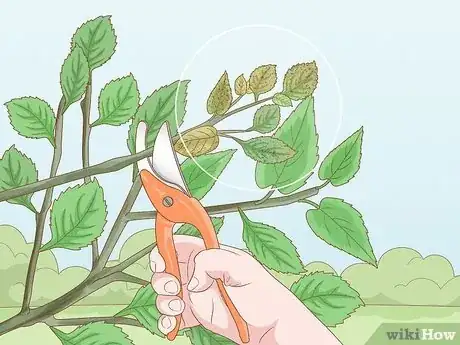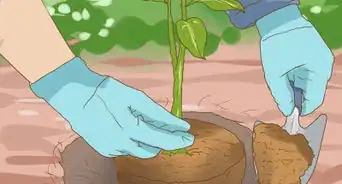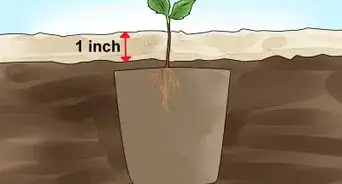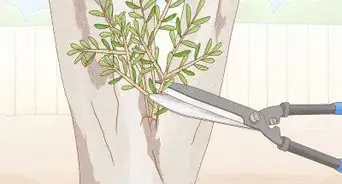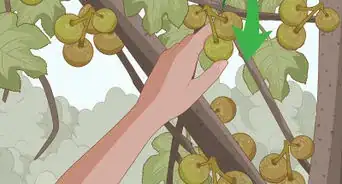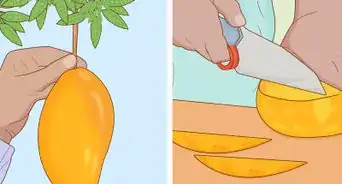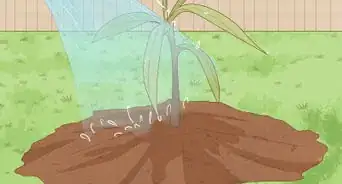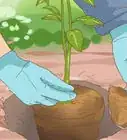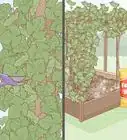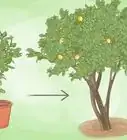This article was co-authored by Lauren Kurtz. Lauren Kurtz is a Naturalist and Horticultural Specialist. Lauren has worked for Aurora, Colorado managing the Water-Wise Garden at Aurora Municipal Center for the Water Conservation Department. She earned a BA in Environmental and Sustainability Studies from Western Michigan University in 2014.
There are 13 references cited in this article, which can be found at the bottom of the page.
wikiHow marks an article as reader-approved once it receives enough positive feedback. This article received 19 testimonials and 100% of readers who voted found it helpful, earning it our reader-approved status.
This article has been viewed 326,370 times.
Crabapple trees are remarkably hardy trees that don’t require much pruning to flourish. An occasional touch up, however, can encourage healthy new growth and help maintain an attractive silhouette. Start by removing any damaged or decaying branches that could potentially invite disease. You can then focus your attention on invasive offshoots, as well as criss-crossing or poorly-formed branches that may steal valuable nutrients from the rest of the tree.
Things You Should Know
- Prune your crabapple tree during late winter or early spring.
- Use a pruning saw or chainsaw to remove unwanted branches.
- Prune dead or dying wood, branches growing inward, and branches that cross or grow too close to each other.
Steps
Performing Heavy Pruning
-
1Do your major pruning during the dormant season. The ideal time to prune a crabapple tree is late winter or early spring, before the new set of leaves begin to appear. You can also get away with pruning in mid- or early winter, though this may make the tree more vulnerable to cold-related injury.[1]
- Hold off on pruning your crabapple tree until after the first killing frost of the season to ensure that it has gone dormant.
- In a pinch, it’s okay to prune in early summer after the tree has finished blooming, although this can increase the risk of "fire blight" and other warm-weather diseases. Aim to have your pruning finished before June (or December, if you’re located in the Southern hemisphere).[2]
-
2Use a pruning saw or chainsaw to take care of heavy pruning. One of these tools will make it easier to get through thick branches and stems. Chainsaws offer more power for quick and easy trimming, while handheld saws allow for greater control so you can only take off as much unwanted growth as you need.
- It may also help to have a pair of telescoping loppers to remove smaller stems and offshoots high up in the canopy of the tree.[3]
Advertisement -
3Cut large limbs where they connect to the trunk. Start by notching the underside of the targeted branch 4–5 inches (10–13 cm) from where it meets the trunk. Then, make a second cut 2–3 inches (5.1–7.6 cm) further out on the limb, this time sawing all the way through. Go back and remove the remaining stump at the collar, or the thick section where the branch grows out the trunk.[4]
- The first undercut you make will prevent excess bark from peeling off the trunk once the limb comes free.[5]
- Avoid cutting perfectly flush with the trunk. Insects and disease-causing organisms can easily find their way into the tree through open wounds in the trunk.
-
4Clear out dead or dying wood first. Inspect the tree for branches that are rotting or appear brittle and colorless. When you find an affected branch, remove the entire limb at its collar.[6]
- If you're unsure whether particular branch is dead, scrape the wood with your fingernail to remove a portion of the bark. If the flesh is underneath is green-white, it’s still alive. If it’s brown or black, it’s most likely dead.
- Keeping your crabapple tree free of dead wood is a good idea at any time of year, since it’s more likely to introduce disease.
-
5Cut away inward-growing branches. Occasionally, a branch will begin to twist in on itself as it grows, reaching back toward the center of the tree rather than out from the center. Saw these branches off close as to the collar as you can without accidentally cutting into the trunk itself or other nearby branches.[7]
- Removing inward-growing branches will give the tree a neater, more uniform shape.
-
6Trim branches that cross or are growing too close together. Similar to inward-growing branches, it’s possible for some branches to become entwined or compete for space. To get rid of branches that are already crossing, take off both branches where they connect to the trunk. For branches that are growing close together but not yet crossing, you can get away with only removing one branch.[8]
- If you decide to remove only one branch, single out the one that looks weakest or most awkwardly placed.
-
7Thin out the lower branches if desired. Low-hanging branches can sometimes interfere with walking, mowing, or other activities that require you to pass beneath the tree. If this is the case, you can deal with them the way you would other large branches by sawing them off close to the trunk.[9]
- Remember to make your cuts as clean as possible so that no stumps remain.
- If your tree’s lower branches aren’t causing a problem, it’s usually best to let them stay.
Keeping Your Tree Healthy
-
1Remove basal suckers. Suckers are spindly, invasive branches that grow underground and sprout around the bases of mature trees. Most suckers are thin and weak enough to remove using a pair of gardening shears. Clip the suckers down low, at the exact point where they emerge from the ground.[10]
- Basal suckers most often originate at the rootstock that the crabapple was grafted onto. If left alone, these tiny branches can develop into whole new trees, complete with different flowers and fruits.[11]
- Removing suckers as soon as you spot them will redirect energy to the parts of the crabapple tree you want to preserve.
-
2Do away with emerging water sprouts. Water sprouts are slender shoots that grow vertically out of the main branches of the tree. Like basal suckers, water sprouts can be snipped with a pair of sharp gardening shears where they emerge from the branch.[12] Cut them away at the base with sharp shears.
- Try to catch emerging water sprouts when they’re still young and green. At this stage, you’ll be able to simply pull them off by hand, which makes it harder for a new one to grow in its place.
- Too many of these undesirable shoots can crowd out the other branches and reduce airflow within the tree, leading to disease, rot, infestations, and other complications.
-
3Keep aesthetic pruning to a minimum. Many arborists are tempted to spur their crabapples’ to grow by continually pruning their live branches. However, this can be risky, as over-pruning can backfire and trigger an explosion of water sprout growth. If you want to shape up your tree, restrict yourself to a few scattered cuts, thinning out smaller branches all the way back to the parent stem.[13]
- The tree’s upper crown is especially likely to produce an overabundance of water sprouts if cut back too much.
- Never remove more than 20% of your crabapple tree’s total live growth in one year. Doing so could severely stunt its growth or even kill it.[14]
-
4Eliminate entire sections of the tree that are infected with fire blight. Fire blight is a bacterial infection that’s common in crabapples, especially after pruning. If you encounter growth that's suffering from fire blight, remove the diseased branch along with the parent stem it’s growing from. Dispose of both parts in a leaf bag or similar container and thoroughly disinfect your tools afterwards.[15]
- Trees affected by fire blight typically have branches that appear burnt or blackened, and may produce shriveled, "mummified" fruit.
- If your notice fire blight on a major limb, you may be able to save it. Try scraping off the outer layer of bark all the way down to the healthy tissue underneath to ensure that the disease doesn’t spread.
-
5Remove any other diseased wood you come across. In addition to fire blight, crabapples are also susceptible to other common plant diseases like scabs, rust, and powdery mildew. Branches showing signs of disease should be cut at the collars and disposed of or discarded a safe distance away from the rest of the tree.[16]
- Always disinfect your gardening tools thoroughly to prevent disease from spreading from one part of the tree to another. The simplest way to do this is to dip the blades in rubbing alcohol before making each new cut.
- If the trunk or root system of the tree appears to be infected, it may be too late to save it.
Expert Q&A
Did you know you can get expert answers for this article?
Unlock expert answers by supporting wikiHow
-
QuestionCan I cut lower branches off my crabapple tree if it's unbalanced? When can I do it?
 Katie GohmannKatherine Gohmann is a Professional Gardener in Texas. She has been a home gardener and professional gardener since 2008.
Katie GohmannKatherine Gohmann is a Professional Gardener in Texas. She has been a home gardener and professional gardener since 2008.
Professional Gardener
-
QuestionShould I paint the cut branch?
 Katie GohmannKatherine Gohmann is a Professional Gardener in Texas. She has been a home gardener and professional gardener since 2008.
Katie GohmannKatherine Gohmann is a Professional Gardener in Texas. She has been a home gardener and professional gardener since 2008.
Professional Gardener
-
QuestionMy tree is growing taller than I want. Can I cut the top off?
 Community Answer"Topping" can seriously weaken the tree, and in crabapples almost always triggers a large amount of water sprout growth. These thin branches will return year after year to ruin the aesthetics anyway, so it's best to leave the top on. If the tree needs to be shortened for safety reasons (such as power lines), hiring a professional gives you the best odds of a healthy, permanent solution. Even then, it's far from guaranteed.
Community Answer"Topping" can seriously weaken the tree, and in crabapples almost always triggers a large amount of water sprout growth. These thin branches will return year after year to ruin the aesthetics anyway, so it's best to leave the top on. If the tree needs to be shortened for safety reasons (such as power lines), hiring a professional gives you the best odds of a healthy, permanent solution. Even then, it's far from guaranteed.
Warnings
- Don’t prune the tips of your tree’s branches. By cutting away the tip, you expose the latent buds underneath and redirect the tree's energy to them. New shoots that grow from latent buds almost always produce malformed branches that can ruin the tree’s attractive shape.⧼thumbs_response⧽
Things You’ll Need
- Handheld pruning saw or chainsaw
- Long-handled loppers
- Gardening shears
- Gardening gloves
- Plastic leaf bag or similar container
References
- ↑ http://extension.colostate.edu/topic-areas/yard-garden/flowering-crabapple-trees-7-424/
- ↑ http://marinmg.ucanr.edu/Marin_Master_Gardener_Independent_Journal_Articles/?uid=17&ds=275
- ↑ https://www.bhg.com/gardening/yard/tools/pruning-tools/
- ↑ https://www.arborday.org/trees/tips/keys-to-pruning.cfm
- ↑ https://www.bhg.com/gardening/trees-shrubs-vines/care/how-to-prune-trees/
- ↑ https://www.thisoldhouse.com/how-to/how-to-prune-crabapple-tree
- ↑ https://newengland.com/yankee-magazine/living/gardening/crabapple/
- ↑ https://extension.unl.edu/statewide/platte/Tree%20Pruning%20FAQs.pdf
- ↑ https://newengland.com/yankee-magazine/living/gardening/crabapple/
- ↑ https://www.yourgardensanctuary.com/overgrown-crabapple-pruning-part1/
- ↑ http://extension.colostate.edu/topic-areas/yard-garden/flowering-crabapple-trees-7-424/
- ↑ http://garden.org/ediblelandscaping/?page=201006-fruit-tree-care
- ↑ https://www.gardendesign.com/trees/pruning-a-crab-apple.html
- ↑ https://www.ext.nodak.edu/extnews/hortiscope/tree/crbapple.htm
- ↑ http://ipm.ucanr.edu/PMG/PESTNOTES/pn7414.html
- ↑ http://extension.colostate.edu/topic-areas/yard-garden/flowering-crabapple-trees-7-424/
About This Article
To prune a crabapple tree, wait until it's late winter or early spring to do heavy pruning so your tree doesn't get any diseases. When you're ready to prune, use a pruning saw or chainsaw to remove any dead or dying wood. You should also prune off any branches that are growing in toward the center of the tree. If there are any branches that are crossing or growing too close together, cut those off as well. You can also saw off low-hanging branches so it's easier to move around the base of your tree. For tips on doing lighter pruning, scroll down!
